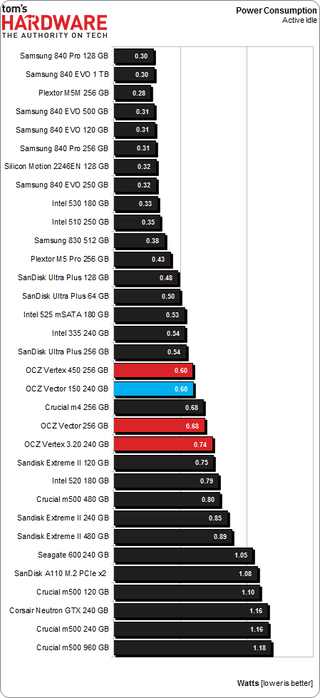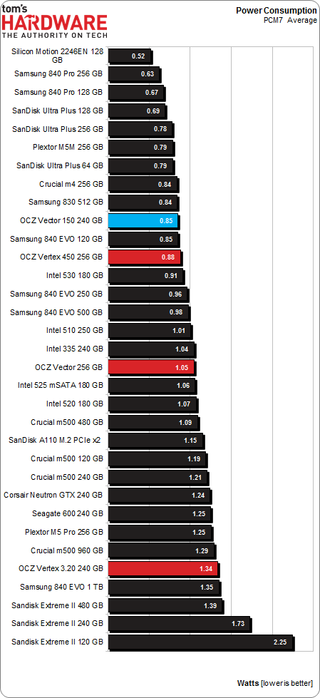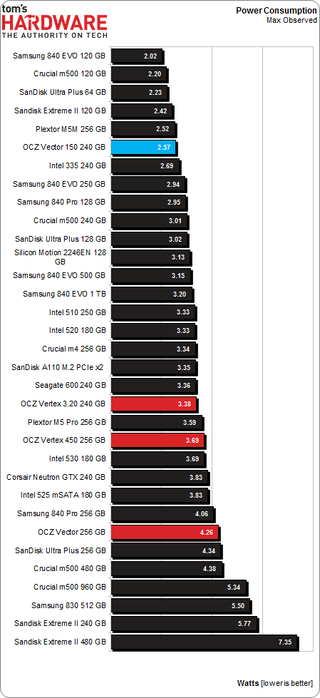OCZ Vector 150 SSD Review: A New Flagship With 19 nm Flash
OCZ is re-launching its flagship consumer SSD as the Vector 150. Armed with 19 nm Toggle-mode flash and new encryption functionality, this new drive is purported to be the pinnacle of of enthusiast-class solid-state storage. Does it live up to the hype?
Results: Power Consumption
Idle Power Consumption
Idle consumption is the most important power metric for consumer and client SSDs. After all, solid-state drives complete host commands quickly, and then drop back down to idle. Aside from the occasional background garbage collection, a modern SSD spends most of its life doing very little. Enterprise-oriented drives are more frequently used at full tilt, making their idle power numbers far less relevant. But this just isn't the case on the desktop, where the demands of client and consumer computing leave most SSDs sitting on their hands for long stretches of time.
Active idle power numbers are critical, especially when it comes to their impact on mobile platforms. Idle means different things on different systems, though. Pretty much every drive we're testing is capable of one or more low-power states, up to and including DevSleep. That last feature is a part of the SATA 3.2 host specification. And while it requires a capable SSD and a compatible platform, enabling it takes power consumption down to a very small number. This is why we test active idle; it's easy to identify, and is still where SSDs spend most of their time.

Despite using the Vector's controller, the Vector 150 demonstrates active idle power consumption identical to the Vertex 450. True, that's only eight-tenths of a watt, but that difference isn't an error in measurement. It's always there. And OCZ did tell us to expect ever so-slightly lower idle power, which is exactly what we see. This isn't on the same level as Samsung, Intel, SanDisk, and Plextor, which are even more conservative, but it's still a respectable outcome.
PCMark 7 Average Power Consumption
If we log power consumption through a workload, even a relatively heavy one, we see that average use is still pretty close to the idle numbers. Maximum power may spike fiercely, but the usage seen during a PCMark 7 run is pretty light. You can see the drives fall back down to the idle "floor" between peaks of varying intensity.

Average power figures fall where we'd expect them, as the new Vector 150 and older Vertex 450 nearly tie. The former flagship Vector averages a few tenths higher.
Let's plot the log data for more detail.
Stay on the Cutting Edge
Join the experts who read Tom's Hardware for the inside track on enthusiast PC tech news — and have for over 25 years. We'll send breaking news and in-depth reviews of CPUs, GPUs, AI, maker hardware and more straight to your inbox.

At this scale, the minute idle power differences between drives aren't even noticeable. What we do see is that the original Vector uses more juice at various points than OCZ's SSDs with sub-25 nm NAND.
Maximum Observed Power Consumption

Sure enough, the Vector 150 shows us the lowest power consumption amongst OCZ's offerings at maximum load. This isn't as big of a win as you might think, though. It's not that maximum power use isn't important. But a client-oriented SSD spends so little time in that state. An extra watt or two every so often typically isn't going to make an appreciable different.
Current page: Results: Power Consumption
Prev Page Results: File Copy Performance Next Page We Love Performance, But Also Want More Value-
jimmysmitty Reply11918040 said:time to upgrade from vertex 4 to 150
I just hope the quality increased. Only because at my last job we had used Vertex 3s for all of our work stations and they one by one started having random issues, from not being detected to wiping the partitions.
I like OCZ because they help lower the price of SSDs but there has to be quality behind the price as well. -
Sakkura Some of the numbers in the bottom diagram on page 4 seem to be off. Look at the Intel 520 180GB for example; the random write bar is longer than the random read bar, but the actual IOPS numbers are the other way around.Reply -
Sakkura Reply
My impression is that OCZ was hit hard by the Sandforce issues, partially as a result of being an early adopter. Their newer drives seem to be reliable.11918340 said:11918040 said:time to upgrade from vertex 4 to 150
I just hope the quality increased. Only because at my last job we had used Vertex 3s for all of our work stations and they one by one started having random issues, from not being detected to wiping the partitions.
I like OCZ because they help lower the price of SSDs but there has to be quality behind the price as well. -
cryan Reply11918441 said:Some of the numbers in the bottom diagram on page 4 seem to be off. Look at the Intel 520 180GB for example; the random write bar is longer than the random read bar, but the actual IOPS numbers are the other way around.
Awesome catch! The 520 seems to have the right bar length, but the label from the Intel 510. I'll sort that out, but that's a genuine not-my-fault problem. One of the very few. I can blame Excel 2013 with confidence, but kudos for the eagle eye.
The random write bar is correct though; the SandForce-based 520, 525, and Intel 530 each pull down more random write IOps than read with incompressible data.
Regards,
CR -
Amdlova I got two SSD vertex 4 128gb on my computer 3770k and on my girlfriend 3470 I never get an single error on this SSD. raid 0 or normal configs. run solid!Reply -
ssdpro Reply11918455 said:My impression is that OCZ was hit hard by the Sandforce issues, partially as a result of being an early adopter. Their newer drives seem to be reliable.
Early on yes, but the 2nd gen SF drives really are pretty darn stable now. OCZ has had solid top tier releases since the Vertex 4. I own Vertex 4 and Vector, will probably get a 150. Hands down the worst thing they ever did was try budget/value offerings like the Petrol. I don't think there is any reason for fanboism, I own Samsung and OCZ drives and all work happily together.
Most Popular

